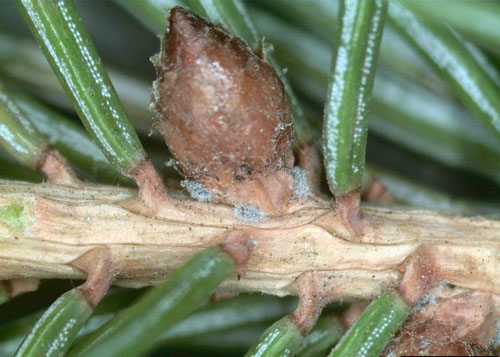Cooley and eastern spruce gall adelgids: Small pests that equal big problems
These tiny insects are difficult to find but can easily be identified by the shoot galls they cause. If galls were abundant last year and an insecticide is needed, it can be applied in spring when the overwintering immature females are still exposed.

Cooley and eastern spruce gall adelgids are the sap-feeding insects that cause relatively long, pinecone-shaped galls to form at the end of current-year shoots on Colorado blue spruce (cooley) and smaller, round-ish or pineapple-shaped galls at the base of new shoots on white and Norway spruce (eastern).
Both species of adelgids overwinter as immature females (stem mothers) in the bark crevices of twigs and around the base of the buds. In spring, the immature females start feeding again and secrete white, wooly wax around their bodies. Mature females lay eggs within this white waxy material. Eggs hatch right about the time that buds are breaking.
The newly hatched nymphs move to the new growth and begin feeding. Their feeding actually changes the cells in the shoots, causing abnormal growth. This growth becomes the characteristic galls, which protect the adelgids for most of the summer. Around August and September, the galls dry, turns red or brown and open, releasing the adelgids that will overwinter.

If you had a lot of galls on your spruce trees last year, the best time to apply an insecticide will be in the spring when the overwintering females are exposed and have not yet been covered by the white waxy wool. This also provides an opportunity to control the adelgid stem mothers before they lay eggs. Adults of both adelgid species become active early, usually at around 25 to 120 growing degree days base 50 degrees Fahrenheit. Scout your spruce fields to evaluate abundance of old galls, and examine twigs and buds for the stem mothers.



 Print
Print Email
Email




